-
Paper Information
- Paper Submission
-
Journal Information
- About This Journal
- Editorial Board
- Current Issue
- Archive
- Author Guidelines
- Contact Us
Architecture Research
p-ISSN: 2168-507X e-ISSN: 2168-5088
2022; 12(1): 12-18
doi:10.5923/j.arch.20221201.02
Received: Jan. 26, 2022; Accepted: Feb. 22, 2022; Published: Mar. 15, 2022

Architectural Design Retrofitting of Congregational Public Spaces with Reference to COVID-19 Pandemic
Abdul Qadir1, Mohammad Arif Kamal2
1Faculty of Architecture and Ekistics, Jamia Millia Islamia, New Delhi, India
2Architecture Section, Aligarh Muslim University, Aligarh, Uttar Pradesh, India
Correspondence to: Mohammad Arif Kamal, Architecture Section, Aligarh Muslim University, Aligarh, Uttar Pradesh, India.
| Email: |  |
Copyright © 2022 The Author(s). Published by Scientific & Academic Publishing.
This work is licensed under the Creative Commons Attribution International License (CC BY).
http://creativecommons.org/licenses/by/4.0/

From over the centuries, pandemics consistently molded urban communities, many health issues have been reflected in the architecture and design of cities. Today, the world is going through an overall crisis of COVID-19 pandemic, the most horrendous in longer than a century giving rise to various challenges to confront this epidemic. The ascent in the quantity of individuals tainted with Coronavirus and the expanding number of passing may bring about a survey of the different Congregational spaces and their renovation planning methodologies to cope with the pandemic. The point of the investigation is to examine the effects of the COVID-19 on the Architectural practices with respect to practical interventions and how will the congregational spaces respond with respect to COVID-19 pandemic.. Therefore, new strategies and implementation principles of emergency design, especially in Congregational spaces (Cinemas/Theatres, Shopping Malls, Libraries must be directed towards healthcare and precautionary measures during the conditions of the pandemic. Thus, it raises the subject of planning for irresistible infections that will most likelyaffect future exploration and practice.
Keywords: COVID-19, Pandemic, Congregational Spaces, Design Retrofitting, Post Implementation Strategies
Cite this paper: Abdul Qadir, Mohammad Arif Kamal, Architectural Design Retrofitting of Congregational Public Spaces with Reference to COVID-19 Pandemic, Architecture Research, Vol. 12 No. 1, 2022, pp. 12-18. doi: 10.5923/j.arch.20221201.02.
Article Outline
1. Introduction
- It is one year that has been passed since this Coronavirus was declared a Global Pandemic, a year of awful loss of lives and livelihoods. However, even with high vulnerability about the way of pandemic, an exit from this wellbeing emergency is progressively noticeable [1]. Since the start, pandemics have reliably formed metropolitan networks; various issues addressed w.r.t planning, designing, healthcare-emergency, and public. The reasonable system for crisis configuration is considered and tested through the ideas of emergency engineering, crisis design, and philanthropic engineering with their undertakings to update ideas both hypothetically and methodologically [2]. Thus, leading values of new strategies and implementation principles of emergency design, especially in architectural practices, must be directed towards the healthcare and precautions to achieve the scope for transformability in existing buildings during the time of the pandemics. Therefore, the aim of this topic is to explore how COVID-19 could reshape our Congregational spaces (public) and how to cope up with it to overcome future virus-like attacks.
2. Research Objectives
- The following are the research objectives of this paper: 1. To observe the problems occurred due to COVID-19 on Architectural Practices (Congregational spaces).2. To analyze what changes can be done in Congregational spaces to cope up with the COVID-19 pandemic.3. To observe how the implementation of various strategies to the Congregational spaces make the things better and will help to cope up with unknown hurdles and challenges.
3. Research Methodology
- In this paper, the study is not limited to theoretical understanding but it is investigations with respect to the practical interventions that how will the congregational spaces respond with respect to COVID-19 pandemic. Initially the study was conducted by exploring online platform and through social media to find out the problems faced by the people during the pandemic times. Following the do’s and don’ts results in analysing through authentic researches and opinion of professionals addressing the changes which could be implemented and thus, qualitative analysis was carried out.The quantitative analysis was explored through the case studies and live situations, which understood the problems faced by the people with respect to the congregational spaces during the lockdowns compared to the pre-pandemic conditions and therefore, by experiencing the people’s perception through live case studies and getting feedback from people and professionals through the google questionnaires survey finally comes out with the in-depth analysis, proposals with the alternative ideas, their genuine recommendable design solutions and interpretation of the desired results.
4. History of Pandemics: It’s Impact on the Cities and Transformation
- COVID-19 isn’t the the world's first pandemic, there have been different pandemics that have hit the world and finished the existences of millions [3], which influenced the wellbeing field as well as left metropolitan effects and financial results. From evaluating the historical backdrop of pandemics earlier, starting from the Athenian plague in 430 BC to the Black Death in Europe in the fourteenth century, we can see more experiences into the impacts and results of changing the plan of urban areas, the city's drafting laws, and the main idea of isolate [4]. In the early nineteenth century; when a progression of the cholera plague struck the world, it was a period of unfortunate metropolitan living. In London 1850; one of the primary explanations behind cholera flare-up was the blending of clean drinking water with wastewater, as per WHO's information [5] [6].Considering the chronicled occasions in the 19th century; the second modern upset, or as it was known as the innovative insurgency which crested between 1870-1914, was a significant period of phenomenal urbanization. During nowadays; urban communities turned out to be thickly populated, brimming with tall private structures, rail lines transportation, and public spaces for amusement and welfare [7]. From that point forward, between 1918-1919; the deadliest respiratory infection pandemic ever "Spanish Flu pandemic" murdered in excess of 50 million individuals around the world, which obviously affected easing back down in metropolitan development and restricting public life for a period to moderate the spread of sickness. For instance, public transportation had been supplanted by strolling in uncrowded roads, the majority of the populace were remaining at home, and walkways around evening time were surprisingly clear [8], which is identical to the current pandemic situation.In Philadelphia 1908; a typhoid fever and cholera episode and brought about by blending sewer and the water source in Schuylkill River. The early preventive stage was to move homes and organizations from the riverbank to be supplanted by an enormous Fairmount park [9]. Coronavirus has been added to a not insignificant rundown of quickly spreading irresistible illnesses in the current century, like tuberculosis in South Africa in 2006, and Ebola in West Africa in 2014, which addresses another test for urban communities to design viably and to transform into sound urban communities [10].At long last, as history consistently helps us to remember the interrelationship between basic illnesses and highlights of urban areas, it could leave blemishes on our urban communities, our social orders and ourselves, we should realize that things won't ever go to be as it was the past. As a result, this point will address city design and urban planning (cities density, streets design, public transportation, public spaces, parks and green areas, and building design) as it relates to population health during the pandemic, when cities face major risks, with increasing numbers of positive cases and deaths related to city size and population density [11]. The COVID-19 pandemic may provide an opportunity to optimize cities by including social behavior during pandemics into planning and design from a health standpoint, see Figure 1.
 | Figure 1. Integration of health, social effects in the city |
5. Literature Review
- Sara Eltarabily and Dalia Elghezanw studied how the epidemic has affected the design of cities and urban regions. Pandemics have shaped cities throughout history, and numerous health challenges have been reflected in architecture and urban design. The COVID-19 pandemic, possibly the worst in more than a century, has created a slew of new issues for communities to deal with. So, stress should be given in this area as healthy cities and the city planning and designing process and supporting the work of the World Health Organization. [12].A research proposal June 2020 by Ghaid Ateek focuses on the Future of Sustainable Architecture: Rethinking COVID-19 a Pandemic or turning point? Will this epidemic reshape our built environment to make it more sustainable, or will it reshape our built environment to make it less sustainable? What role does architecture play in epidemics and the post-pandemic world? Finally, the impact of COVID-19 on people's daily routines in the built environment is discussed [13].Zebun Ahmed focused on the production of temporary make-shift architecture so that we can use large open plan spaces such as stadiums, multipurpose, conference, and wedding halls, among others, to install temporary structures that can serve to provide the same social distancing for communities [14]. Ghoneim et al. analyzed that, as a result of the COVID-19 outbreak, architecture and urbanization will never be the same. Although the present global outbreak poses a threat at all levels of the built environment, developing an antivirus-enabled paradigm to lower the virus's potential hazards or stop it from spreading will take time. This research stimulates the search for appropriate design ideas, trends, and planning theories to provide the necessary viral protection and continue to add more layers in the defense system of our built environment, [15].It has been concluded from the research done by Durga Shanbhag and Manorma Patil that the methodology used here takes into account a study of the current situation, the necessity for automation to limit contagion, and technological aspects developing and implementing planning and design techniques to bring a shift to previously standardized space geometry, as well as planning and design ideas that can lead to antibacterial rooms [16]. Emmanuel et al. analyzed that the sustainable design strategies are targeted at finding architectural solutions that reassure the well-being and coexistence of inorganic features, living organisms and humans that make up the ecosystem [17].Abdelmoneim Khogali studied some techniques used by Dar Al Uloom University's College of Architectural Engineering. Adding value entails refining the e-learning process in preparation for the forthcoming semesters and resolving any issues that may arise in order to provide a better education. To accomplish this goal, the researcher will send a survey to the students in order to assess their experience and record the positive aspects, as well as to find a solution to the negative points in order to resolve these issues [18].Takewaki concluded that the pandemic COVID-19 reminds us that we must also look into resilience in terms of infection risks. Buildings and transportation networks are the most common areas where people become sick. In buildings, three elements that are regarded to be major infection hazards (closed spaces with no ventilation, dense gatherings, and close proximity) frequently occur.For this reason, From the standpoint of lowering the danger of infection, the role of space planning and design, as well as architectural engineering, is critical utilizing a wide range of architectural and regional planning expertise and technology [19]. On the other hand, Nick et al stated that due to the COVID-19 pandemic, the industry has been compelled to disrupt its own planning, procedures, models, and operations as a result of this tidal change in conditions. So, the planning and designing of the spaces must be rescheduled [20]. The need to adapt societal designs, community spaces, common activities, common passageway designs, and internal space designs will result in lifestyle modifications at both the micro and macro levels [21].
6. Primary Data Collection
- The primary data collection involves the accompanying inquiries about the hindrances with respect to pandemic by the perspectives of individuals and experts as:1. Where do the problems lie with reference to congregational spaces? (i.e. their categorization) and in which domain do the problem lies? (Including Problem statements).2. Doing the brief case study of the native city addressing the live conditions.3. Subsequent to getting out the issues and the contextual investigation, the next step is to get some more information regarding the ideas of the architects/experts that what should be possible in congregational spaces to cope up with the COVID-19 pandemic.4. How the implementations to the strategies make the things better in future combatting the pandemics (asking about problems, suggestions and implementations strategies) which comes out by getting the responses.
6.1. Problems and Domain
- Question 1) which of the following formal Congregational spaces has been majorly hit by COVID-19?Response 1) majorly hit: Cinemas/Theatres, Libraries, Shopping Malls (Based on 72 responses)
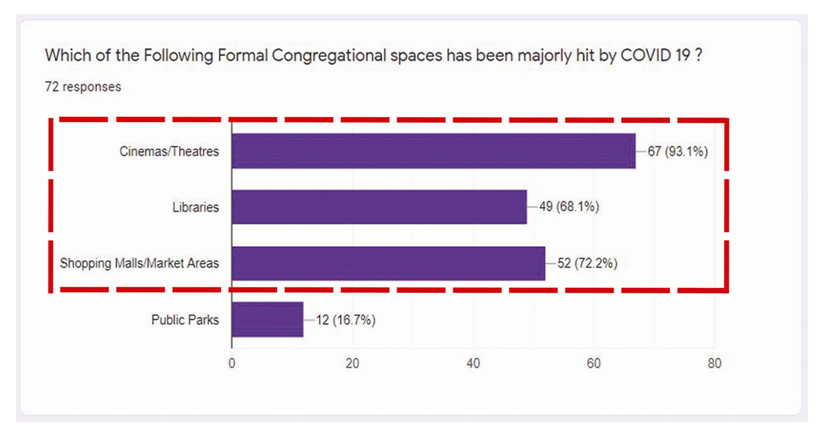 | Figure 2. Survey analysis for identifying formal congregational spaces |
 | Figure 3. Survey analysis for the problem/ issues domain |
6.2. Case Studies
- The rundown of issues with the perspectives of individuals and experts yet getting an affirmation is likewise very clear in the essential information assortment thus Case Studies were done in the local city Saharanpur with reference to the following congregational areas:1. GNG Shopping Mall, Saharanpur, India2. GNG Shopping Mall Multiplex/Theatre, Saharanpur3. Public Library, Nagar Nigam, Saharanpur
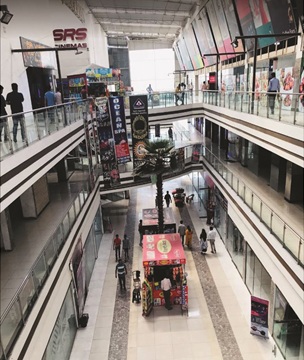 | Figure 4. Present condition of GNG Shopping Mall at Saharanpur, India |
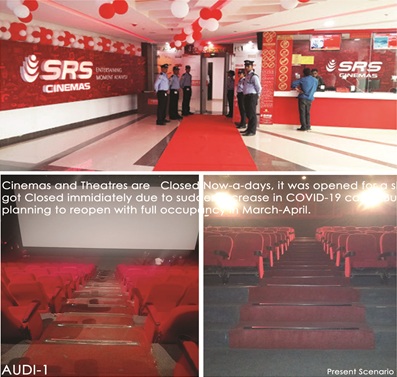 | Figure 5. Present scenario of Cinemas/theatres at Saharanpur, India |
 | Figure 6. Present scenario of the Public library at Saharanpur, India |
6.3. Questionnaire Survey Analysis
- Question 4) Will the area of congregational spaces change in future w.r.t COVID-19?Response 4) Yes (Based on 72 responses)Question 5) As an architect what changes do you want to suggest on the following spaces viz. (Cinemas/Theatres, Libraries, Shopping Malls/Market areas, public parks) to make the building/spaces corona proof?Response 5) Most of the reactions that got subsequent to drifting the survey questionnaire are as follows:1. Having more mechanized systems2. Natural ventilation3. Exhaust system4. Segregation5. Use of air purifiers6. Providing more isolation zones/areas(Based on 72 responses)Question 6) Is there any scope for alternative strategies currently (additions in designs and planning of spaces) there in terms of architectural practices to cope up with COVID-19?Response 6) ‘Yes’ (Based on 72 responses) Question 7) As COVID-19 is a global pandemic, so, how can the current public spaces be altered to make them usable in COVID-19 scenario, i.e. will their function change or not?Response 7) Most of the reactions that got subsequent to drifting the survey questionnaire are as follows:1. Yes, Change in function2. Scope for alternations3. Renovation of public spaces4. Implementation of new techniques(Based on 72 responses)
7. Design Recommendations
- The Analysis from Research Papers, Articles, Blogs and Questionnaires oriented more towards Planning and Design, Social Issues.• Planning and Design: Crowd Division / Equipment / Accessories.• Social Issues: Not maintaining Social DistancingAlso having installation to novelty in the existing spaces, equipment, mechanized Systems.1. Fibre-Screen in existing structures between the chairs.
 | Figure 7. Graphical representation of installation of the fibre screens |
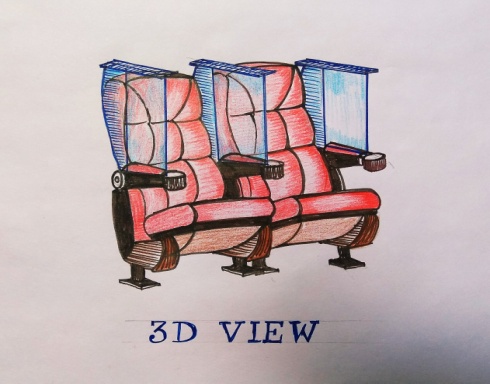 | Figure 8. The 3D view illustrating the fibre screens |
 | Figure 9. Proposal design of the capsule chairs |
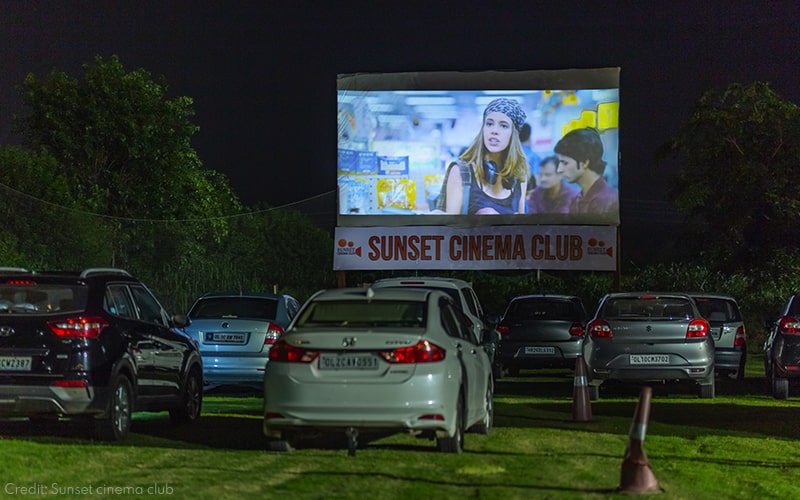 | Figure 10. Drive in Cinemas as an alternative to the future |
 | Figure 11. Proposed design of handrails and glass walls to maintain social distancing |
 | Figure 12. Proposed design of Isolation cubicle units |
8. Conclusions
- There can be shortage of space to design a new concept and proposal especially focusing towards the COVID-19 pandemic. Thus, it had come to such an extent that healthcare professionals had to take parks and playgrounds as temporary Covid shelters during the time of strict lockdown of Coronavirus pandemic. So, there must be some provisions to be practiced from the root level itself, i.e. proposal of designing such a space that can be easily transform into an emergency shelter for the effected people or to have some quick alternative strategies by making short interventions in the existing structures. Therefore concluding the study remarks that, if such sort of provisions get drilled in Architecture then hopefully it can up come as an Alternative/ Post Implementation Strategies to Design and get prepared for the pandemics.
 Abstract
Abstract Reference
Reference Full-Text PDF
Full-Text PDF Full-text HTML
Full-text HTML